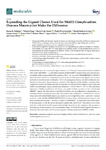Expanding the Ligand Classes Used for Mn(II) Complexation: Oxa-aza Macrocycles Make the Difference

Use this link to cite
http://hdl.handle.net/2183/27664Collections
- Investigación (FCIE) [1228]
Metadata
Show full item recordTitle
Expanding the Ligand Classes Used for Mn(II) Complexation: Oxa-aza Macrocycles Make the DifferenceAuthor(s)
Date
2021-03-10Citation
Kálmán, F.K.; Nagy, V.; Uzal-Varela, R.; Pérez-Lourido, P.; Esteban-Gómez, D.; Garda, Z.; Pota, K.; Mezei, R.; Pallier, A.; Tóth, É.; Platas-Iglesias, C.; Tircsó, G. Expanding the Ligand Classes Used for Mn(II) Complexation: Oxa-aza Macrocycles Make the Difference. Molecules 2021, 26, 1524. https://doi.org/10.3390/molecules26061524
Abstract
[Abstract] We report two macrocyclic ligands based on a 1,7-diaza-12-crown-4 platform functionalized with acetate (𝑡O2DO2A²⁻) or piperidineacetamide (𝑡O2DO2AMᴾⁱᵖ) pendant arms and a detailed characterization of the correspondingMn(II) complexes. The X-ray structure of [Mn(𝑡O2DO2A)(H₂O)]∙.2H₂O shows that the metal ion is coordinated by six donor atoms of the macrocyclic ligand and one water molecule, to result in seven-coordination. The Cu(II) analogue presents a distorted octahedral coordination environment. The protonation constants of the ligands and the stability constants of the complexes formed with Mn(II) and other biologically relevant metal ions (Mg(II), Ca(II), Cu(II) and Zn(II)) were determined using potentiometric titrations (∕ = 0.15 M NaCl, T = 25 ºC). The conditional stabilities of Mn(II) complexes at pH 7.4 are comparable to those reported for the cyclen-based 𝑡DO2A²⁻ ligand. The dissociation of the Mn(II) chelates were investigated by evaluating the rate constants of metal exchange reactions with Cu(II) under acidic conditions (∕ = 0.15MNaCl, T = 25 ºC). Dissociation of the [Mn(𝑡O2DO2A)(H₂O)] complex occurs through both proton- and metal-assisted pathways, while the [Mn(𝑡O2DO2AMᴾⁱᵖ)(H₂O)] analogue dissociates through spontaneous and proton-assisted mechanisms. The Mn(II) complex of 𝑡O2DO2A²⁻ is remarkably inert with respect to its dissociation, while the amide analogue is significantly more labile. The presence of a water molecule coordinated to Mn(II) imparts relatively high relaxivities to the complexes. The parameters determining this key property were investigated using ¹⁷O NMR (Nuclear Magnetic Resonance) transverse relaxation rates and ¹H nuclear magnetic relaxation dispersion (NMRD) profiles.
Keywords
Manganese
Magnetic resonance imaging
Stability
Dissociation kinetics
Water exchange
Contrast agents
Macrocycles
Magnetic resonance imaging
Stability
Dissociation kinetics
Water exchange
Contrast agents
Macrocycles
Editor version
Rights
Attribution 4.0 International
ISSN
1420-3049






